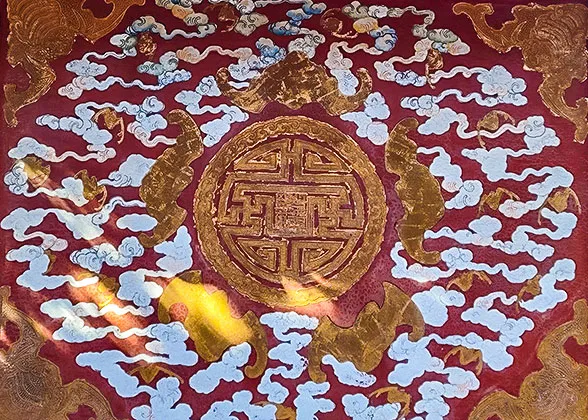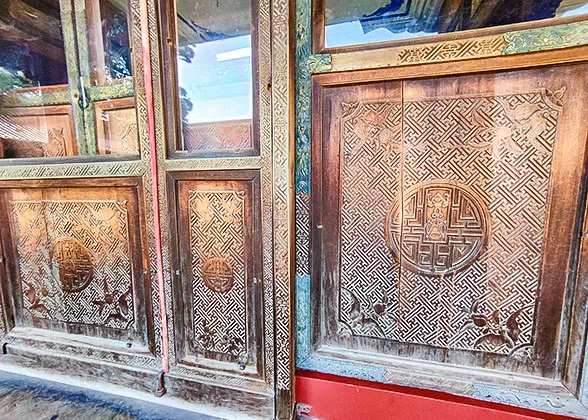Hall of the Supreme Principle (Taijidian)
Dating back to 1420 and renamed twice, the Hall of Supreme Principle (Taijidian) served as a dwelling for imperial concubines in the Ming and Qing dynasties (1368~1911), and was also a temporary residence for two emperors.
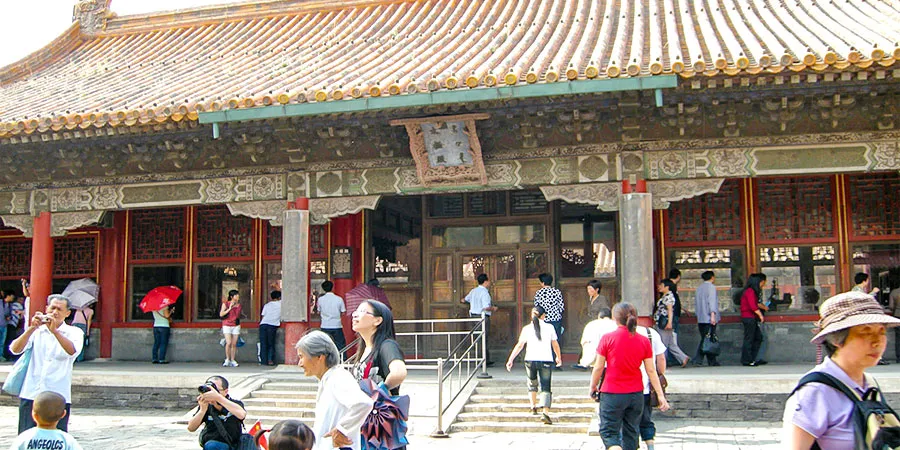 |
| Hall of Supreme Principle |
History
1420~1644, Ming Dynasty: Imperial Concubines' Palace
Built in 1420, the Hall of the Supreme Principle initially served as an ordinary residence for imperial concubines within the Six Western Palaces, called the Palace of Endless Prosperity. In 1535, Emperor Jiajing (1507~1567) renamed it Auspicious Beginnings Palace.
Emperor Jiajing renamed the palace "Auspicious Beginnings", where his father was born, aimed to emphasize his father's imperial status and underscore the legitimacy of his own reign.
At the start, both Jiajing and his father were feudal lords. However, after Emperor Zhengde (1491~1521) died without an heir in 1521, the court decided that Jiajing, Zhengde’s cousin, should ascend the throne.
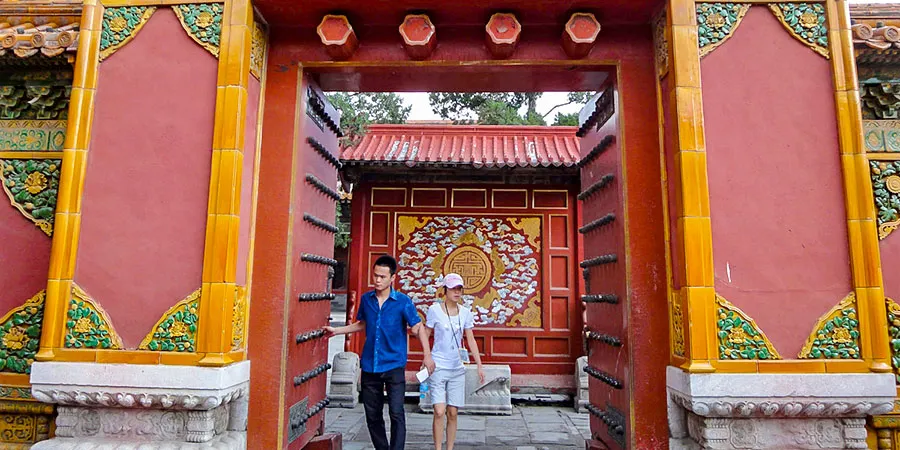 |
| Upon Entering the Gate of Supreme Principle |
The court followed Confucian traditions, which advocated that an emperor's father must also be an emperor. Therefore, they asked Jiajing to recognize Emperor Hongzhi (1470~1505), Zhengde’s father, as his father, demoting his birth father to the status of uncle.
Refusing to comply, Emperor Jiajing posthumously honored his father as an emperor, and give the birthplace of his father the new name "Auspicious Beginnings" to express this was where his father thrived to be the emperor.
1644~1911, Qing Dynasty: Home to Imperial Concubines, Briefly Resided by Emperor Xianfeng
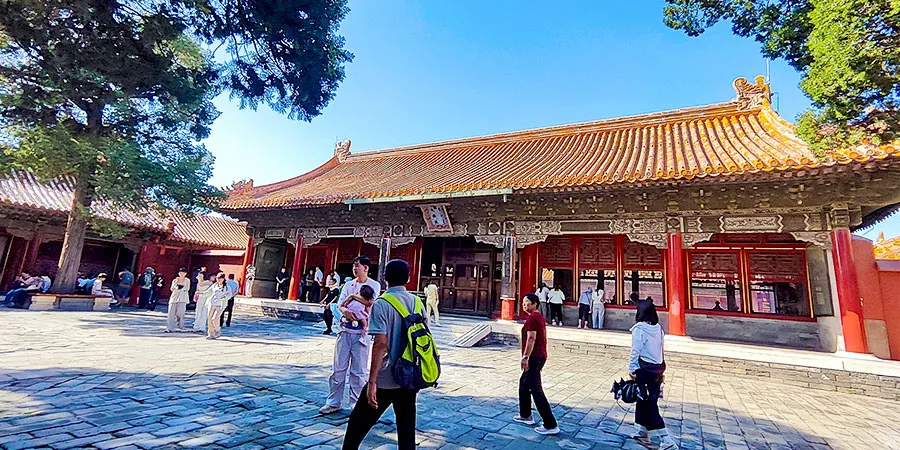 |
| Supreme Harmony Hall Courtyard |
As the Qing Court resided in the Forbidden City, the Palace of Auspicious Beginnings was still home to emperor's concubines. In 1859, Emperor Xianfeng (1831~1861) renamed the Palace of Auspicious Beginnings to the Hall of Supreme Principle and connected it with the Palace of Eternal Spring to the north, creating a spacious space with four courtyards.
There are two purposes: to celebrate Xianfeng's tenth anniversary on the throne and his 30th birthday by creating a more expansive living area, and to provide easy access for him, who suffered from leg issues, to the Hall of Mental Cultivation (Yangxindian), where he conducted state affairs, just 10 meters (11 yards) away from the area's south gate.
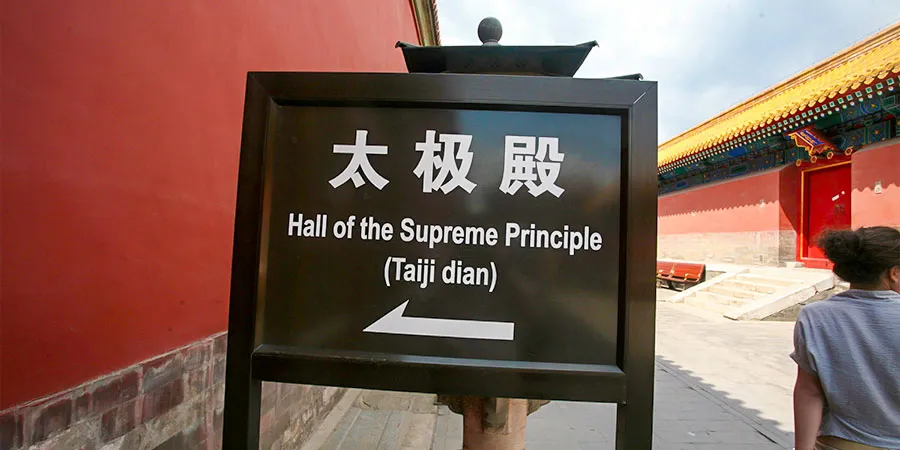 |
| Sign of the Supreme Principle Hall |
The term "Supreme Principle", pronounced as "Taiji" or "Tai Chi" in Chinese, signifies the origin of all things and symbolizes renewal. Emperor Xianfeng chose this name to bestow new life here and the rejuvenation of his fallen empire.
In addition, in the Forbidden City, "palace" traditionally signifies residential quarters, whereas "hall" indicates locations for conducting state affairs. Hence, renaming it to "hall" better reflects its new functional purpose.
What to See Today
The area of the Hall of Supreme Principle centers around the main hall, covered with yellow glazed tiles named "Supreme Principle" itself. Behind it stands Hall of Cosmic Origin, serving as a gateway hall to Palace of Eternal Spring. Auxiliary halls flank both the east and west sides of the main hall and rear hall, enclosing an area comprising two courtyards.
Today, the Hall of Supreme Principle has been restored to its original state as it was in the late Qing Dynasty (1644~1911), with the courtyard open and the rooms closed but allowing visitors to glimpse the imperial concubines' life through glass windows.
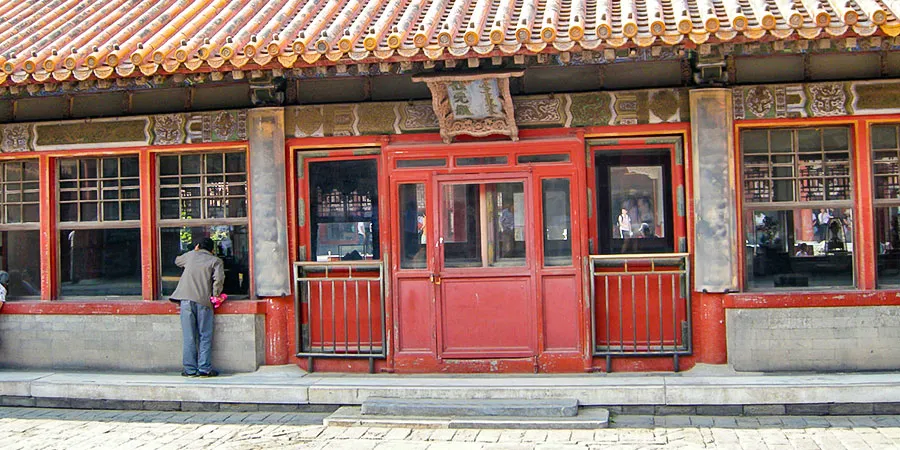 |
| Hall of Cosmic Origin |
Bats Decorations
Bats are the most common decorative motifs in the Hall of Supreme Principle, representing fortune in Chinese culture. When Emperor Xianfeng moved here, he incorporated these bat decorations, hoping to bring happiness and stability amidst the turmoil of the late Qing Dynasty. These motifs appear throughout the hall, from the entrance screen wall to the interior furnishings.
Upon entering the courtyard, you are greeted by a red wooden screen wall. As approaching, you can see 4 bats at each corner of the screen wall and 18 small bats fluttering amidst colorful clouds. In the center, 5 large bats encircling the character "longevity", collectively symbolizing "myriad blessings and longevity".
|
|
Inside the main hall, bat motifs appear in various forms: the ceiling features a blue plaster relief of five bats surrounding the longevity character, while furnishings include a fan embellished with red bats (symbolizing "boundless blessings and wealth"), cupboard doors with copper bat-shaped handles, lanterns with jade bat tassels, and embroidered tablecloths and carved mirror screens featuring intricate bat designs.
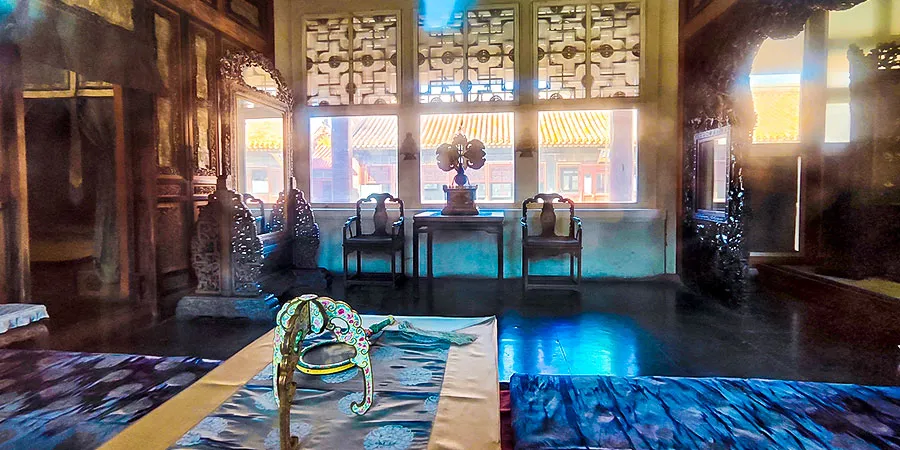 |
| Inside the Main Hall |
Six-Dragon Screen Wall
Nestled in the center of the southern wall, the Six-Dragon Screen Wall stands as a testament to the palace's newly elevated status following Emperor Xianfeng's residence. Adorned with dragon decorations, it symbolizes ultimate prestige and power in Chinese culture.
At the heart of this screen lies a beautifully crafted colored glaze panel in a diamond shape. Inside it, two dragons in a striking yellow glaze ascend and descend gracefully amidst swirling clouds. Each of the four corners of the screen features an additional dragon, their heads turning towards the central panel as if paying homage to the imperial authority it represents.
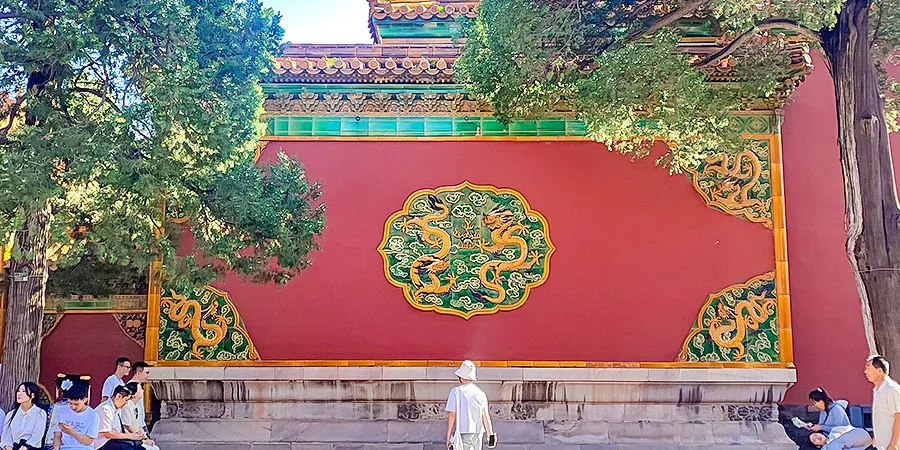 |
| Six-Dragon Screen Wall |
Remarkable Residents in the Hall of Supreme Principle
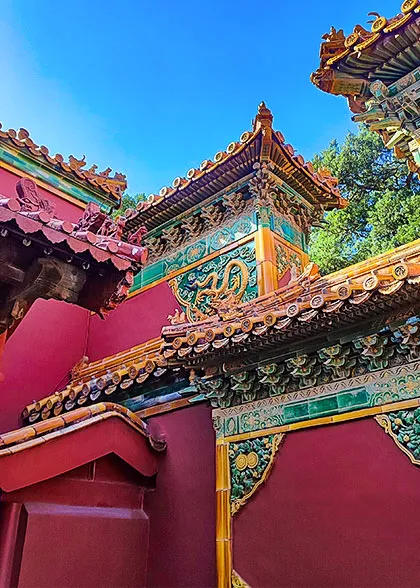 |
| A Screen Wall Corner Seen from Outside |
Loving Couple: Emperor Wanli & Empress Wang
The palace once witnessed the profound love between Emperor Wanli (1653~1620) and Empress Wang (1654~1620).
In March 1596, the Palace of Heavenly Purity where Emperor Wanli resided and the Palace of Earthly Tranquility where Empress Wang lived were destroyed by a fire. As a result, Emperor Wanli and Empress Wang moved into the palace together.
For the next twenty-four years, they shared meals and slept side by side there, cherishing each other's company. Despite the rebuilding of their former palaces, they chose to stay in this smaller place, enjoying their intimate life together.
Their love story came to an end in 1620 when Empress Wang succumbed to a lingering illness. Five days after her passing, Emperor Wanli, overcome with grief, also fell gravely ill. Just three months later, he too departed this world, following his beloved wife in death.
Concubine Yu: Backbone in Forbidden City's Turbulent Times
Concubine Yu (1856~1932) was the final resident of the Hall of Supreme Principle. In 1900, amidst the Eight-Power Allied Forces' invasion, significant rulers of the Forbidden City fled westward in haste, including Empress Dowager Cixi (1835~1908), emperor and empress, abandoning Concubine Yu and other concubines to their fate.
At the crucial moment, Yu took the initiative to manage the Forbidden City. She assigned people to guard the Forbidden City and summoned ministers to negotiate with foreign powers for the imperial palace's safety.
During this time, Von Waldersee (1832~1904), the commander of the Eight-Power Allied Forces, visited Yu. Impressed by her dignity, he ordered strict protection for the concubines and ensured their daily needs.
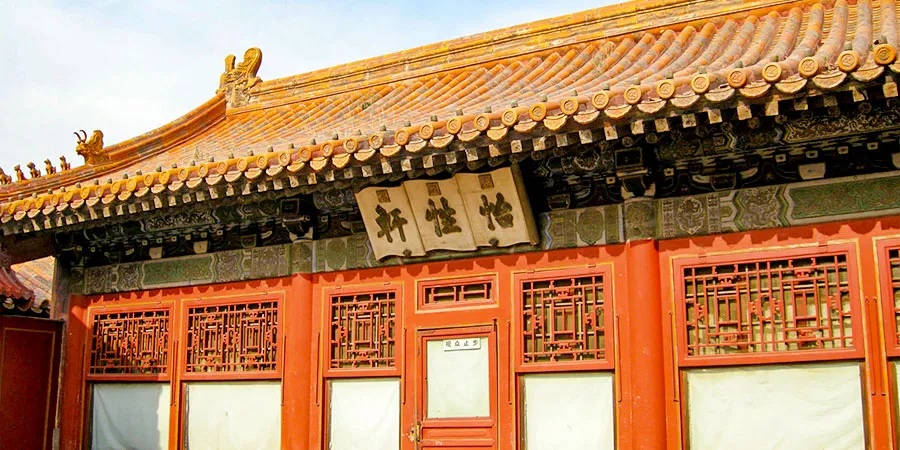 |
| Side Hall in the Backyard |
See more Six Western Palaces
- Last updated on Oct. 09, 2025 by Jally Zhang -
